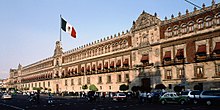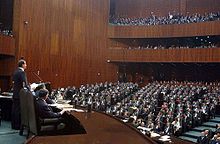Courtesy: Wikipedia
| Mexico |
 This article is part of the series: Politics and government of Mexico |
Other countries · Atlas Mexico Portal |
Main article: Politics of Mexico
The United Mexican States are a federation whose government is representative, democratic and republican based on a presidential system according to the 1917 Constitution. The constitution establishes three levels of government: the federal Union, the state governments and the municipal governments. All officials at the three levels are elected by voters through first-past-the-post plurality, proportional representation or are appointed by other elected officials.
The federal government is constituted by the Powers of the Union, the three separate branches of government:
Legislature
Legislative: the bicameral Congress of the Union, composed of a Senate and a Chamber of Deputies, which makes federal law, declares war, imposes taxes, approves the national budget and international treaties, and ratifies diplomatic appointments.[77]Executive
Executive: the President of the United Mexican States, who is the head of state and government, as well as the commander-in-chief of the Mexican military forces. The President also appoints the Cabinet and other officers. The President is responsible for executing and enforcing the law, and has the authority of vetoing bills.[78]Judiciary
Judiciary: The Supreme Court of Justice, comprised by eleven judges appointed by the President with Senate approval, who interpret laws and judge cases of federal competency. Other institutions of the judiciary are the Electoral Tribunal, collegiate, unitary and district tribunals, and the Council of the Federal Judiciary.[79]All elected executive officials are elected by plurality (first-past-the-post). Seats to federal and state legislatures are elected by a system of parallel voting that includes plurality and proportional representation.[80] The Chamber of Deputies of the Congress of the Union is conformed by 300 deputies elected by plurality and 200 deputies by proportional representation with closed party lists[81] for which the country is divided into 5 electoral constituencies or circumscriptions.[82]
The Senate is conformed by a total of 128 senators: 64 senators, two for each state and two for the Federal District, elected by plurality in pairs; 32 senators assigned to the first minority or first-runner up (one for each state and one for the Federal District), and 32 are assigned by proportional representation with closed party lists for which the country conforms a single electoral constituency.[81]
According to the constitution, all constituent states of the federation must have a republican form of government composed of three branches: the executive, represented by a governor and an appointed cabinet, the legislative branch constituted by a unicameral congress and the judiciary, which will include called state Supreme Court of Justice. They also have their own civil and judicial codes.
In the 2009–2012 Congress of the Union, seven parties are therein represented; four of them, however, have not received neither in this nor in previous congresses more than 4% of the national votes.[83] The other three parties have historically been the dominant parties in Mexican politics:
 National Action Party (Partido Acción Nacional, PAN): a right-wing conservative party founded in 1939. PAN has gained plurality, but not absolute majority in several parliamentary elections. In 2000, it gained the presidency for the first time. It belongs to the Christian Democrat Organization of America.[84]
National Action Party (Partido Acción Nacional, PAN): a right-wing conservative party founded in 1939. PAN has gained plurality, but not absolute majority in several parliamentary elections. In 2000, it gained the presidency for the first time. It belongs to the Christian Democrat Organization of America.[84] Institutional Revolutionary Party (Partido Revolucionario Institucional, PRI): a center-left party that ascribes to social democracy—it is a member of Socialist International—[85] founded in 1929 to unite all the factions of the Mexican Revolution. Prominent left-wing Mexican politicians have been members of the party. Having dominated Mexican politics since the Revolution, PRI includes diverse factions including some center-right members.
Institutional Revolutionary Party (Partido Revolucionario Institucional, PRI): a center-left party that ascribes to social democracy—it is a member of Socialist International—[85] founded in 1929 to unite all the factions of the Mexican Revolution. Prominent left-wing Mexican politicians have been members of the party. Having dominated Mexican politics since the Revolution, PRI includes diverse factions including some center-right members. Party of the Democratic Revolution (Partido de la Revolución Democrática, PRD): a left-wing party,[86] founded in 1989 as the successor of the coalition of socialists and liberal parties, the National Democratic Front that had presented the candidacy of Cuauhtémoc Cárdenas in the controversial 1988 elections.
Party of the Democratic Revolution (Partido de la Revolución Democrática, PRD): a left-wing party,[86] founded in 1989 as the successor of the coalition of socialists and liberal parties, the National Democratic Front that had presented the candidacy of Cuauhtémoc Cárdenas in the controversial 1988 elections.
In 2006, Felipe Calderón of the PAN faced Andrés Manuel López Obrador of the PRD in a very close election (0.58% difference), by simple plurality—the Mexican electoral system does not include runoff voting. López Obrador contested the elections, but on September 6, 2006, Felipe Calderón was declared President-elect by the Electoral Tribunal. His cabinet was sworn in at midnight on December 1, 2006 and Calderón was handed the presidential band by outgoing Vicente Fox at Los Pinos. He was officially sworn as President on the morning of December 1, 2006 in Congress.



No comments:
Post a Comment